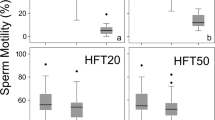Abstract
Purpose: Our purpose was to study the chemotactic responsiveness of human spermatozoa from normal and pathological semen samples to follicular fluid (FF), as well as the effect exerted by capacitation on sperm chemotaxis.
Methods: The chemotactic responsiveness of human spermatozoa to FF was tested by an accumulation assay chamber in which they were allowed to migrate through a microporous membrane and accumulate in a compartment filled with FF or control medium. The percentage of cells with hyperactivated motility among migrated sperm was objectively assessed by CASA and its relationship to the accumulation rate was studied. Single FFs were tested with single normospermic or dyspermic semen samples; the same FF was tested with different semen specimens. The influence of capacitation onto the chemotactic responsiveness to FF was investigated by comparing the accumulation rate of spermatozoa from normal and pathological samples after incubation under capacitating conditions for 1 or 6 hr.
Results: Some FFs (“active” FFs) effectively attracted human spermatozoa from normospermic samples up to a dilution factor of 1:500 (v:v) with control medium. A wide range of responses was observed when the same FF was tested with different normal semen samples. A longer time under capacitating conditions increased both the chemotactic responsiveness of normal semen and its ability to undergo the acrosome reaction (AR) in response to A23187. Pathological semen had an impaired chemotactic responsiveness to “active” FF that was not enhanced by increasing the time spent under capacitating conditions. Dyspermic semen was also less responsive to A23187, a finding suggesting incomplete capacitation.
Conclusions: Chemotactic responsiveness to FF is acquired in parallel to or as part of the capacitation process. Dyspermic semen samples have an impaired capacity to achieve both capacitation and chemotactic responsiveness to follicular factors.
Similar content being viewed by others
REFERENCES
Shimomura HL, Dangott LJ, Garbers DL: Covalent coupling of a resact analogue to guanylate cyclase. J Biol Chem 1986; 261:15778-15782
Ward GE, Garbers DL, Vacquier VD: Effects of extracellular egg factors on sperm guanylate cyclase. Science 1985;227:768-770
Repaske DR, Garbers DL: A hydrogen ion flux mediates stimulation of respiratory activity by speract in sea urchin spermatozoa. J Biol Chem 1983;258:1524-1529
Shapiro BM, Cook S, Quest AFG, Oberdof J, Wothe D: Molecular mechanisms of sea-urchin sperm activation before fertilization. J Reprod Fertil 1990;42 (Suppl):3-8
Kunz G, Beil D, Deininger H, Wildt L, Leyendecker G: The dynamics of rapid sperm transport through the female genital tract: evidence from vaginal sonography of uterine peristalsis and hysterosalpingoscintigraphy. Hum Reprod 1996;11:627-632
Pacey AA, Hill CJ, Scudamore IW, Warren MA, Barratt CLR, Cooke ID: The interaction in vitro of human spermatozoa with epithelial cells from the human uterine (fallopian) tube. Hum Reprod 1995;10:360-366
Eisembach M, Tur-Kaspa I: Human sperm chemotaxis is not enigmatic anymore. Fertil Steril 1994;62:233-235
Eisembach M: Sperm changes enabling fertilization in mammals. Curr Opin Endocrinol Diabetes 1995;2:468-475
Villanueva-Diaz C, Vadillo-Ortega F, Kably-Ambe A, Diaz-Perez MA, Karchmer Krivitzky S: Evidence that human follicular fluid contains a chemoattrctant for spermatozoa. Fertil Steril 1990;54:1180-1182
Villanueva-Diaz C, Arias-Martinez J, Bustos-Lopez H, Vadillo-Ortega F: Novel model for study of human sperm chemotaxis. Fertil Steril 1992;58:392-395
Cohen-Dayag A, Ralt D, Tur-Kaspa I, Manor M, Makler A, Dor J, Mashiach S, Eisembach M: Sequencial acquisition of chemotactic responsiveness by human spermatozoa. Biol Reprod 1994;50:786-790
Ralt D, Manor M, Cohen-Dayag A, Tur-Kaspa I, Ben-Shlomo I, Makler A, Yuli I, Dor J, Blumberg S, Mashiach S, Eisembach M: Chemotaxis and chemokinesis of human spermatozoa to follicular factors. Biol Reprod 1994;50:774-785
Ralt D, Goldenberg M, Fetterolf P, Thompson D, Dor J, Maschiach S, Garbers DL, Eisembach M: Sperm attraction to a follicular factor(s) correlates with human egg fertilizability. Proc Natl Acad Sci USA 1991;88:2840-2844
Villanueva-Diaz C, Arias-Martinez J, Bermejo-Martinez L, Vadillo-Ortega F: Progesterone induces human sperm chemotaxis. Fertil Steril 1995;64:1183-1188
Zamir N, Riven-Kreitman R, Manor M, Makler A, Blumberg S, Ralt D, Eisenbach M: Atrial natriuretic peptide attracts human spermatozoa in vitro. Biochem Biophys Res Commun 1993;197:116-122
Anderson RA, Feathergill KA, Rawlins RG, Mack SR, Zaneveld LJ: Atrial natriuretic peptide:Achemoattractant of human spermatozoa by a guanylate cyclase-dependent pathway. Mol Reprod Dev 1995;40:371-378
Cohen-Dayag A, Tur-Kaspa I, Dor J, Mashiach S, Eisembach M: Sperm capacitation in humans is transient and correlates with chemotactic responsiveness to follicular factors. Proc Natl Acad Sci USA 1995;92:11039-11043
Gnessi L, Fabbri A, Silvestroni L, Moretti C, Fraioli F, Pert CB, Isidori A: Evidence for the presence of specific receptors for N-formyl chemotactic peptides on human spermatozoa. J Clin Endocrinol Metab 1986;63:841-846
Hong CY, Chaput de Saintonge DM, Turner P: A simple method to measure drug effects on human sperm motility. Br J Clin Pharmacol 1981;11:385-387
Paul M, Sumpter JP, Lindsay KS: Action of pentoxyfilline dirtectly on semen. Hum Reprod 1995;10:354-359
Cross NL, Morales P, Overstreet JW, Hanson FW: Two simple methods for detecting acrosome-reacted human sperm. Gamete Res 1986;15:213-226
Mendoza C, Tesarik J: Effect of follicular fluid on sperm movement characteristics. Fertil Steril 1990;54:1135-1139
Falcone L, Soldati G, Piffaretti-Yanez A, Marchini M, Eppemberger U, Balerna M: Follicular fluid enhances sperm motility and velocity in vitro. Fertil Steril 1991;55:619-623
Mbizvo MT, Burkman LJ, Alexander N: Human follicular fluid stimulates hyperactivated motility in human sperm. Fertil Steril 1991;54:708-712
Author information
Authors and Affiliations
Rights and permissions
About this article
Cite this article
Tacconis, P., Revelli, A., Massobrio, M. et al. Chemotactic Responsiveness of Human Spermatozoa to Follicular Fluid Is Enhanced by Capacitation but Is Impaired in Dyspermic Semen. J Assist Reprod Genet 18, 36–44 (2001). https://doi.org/10.1023/A:1026402830232
Issue Date:
DOI: https://doi.org/10.1023/A:1026402830232




